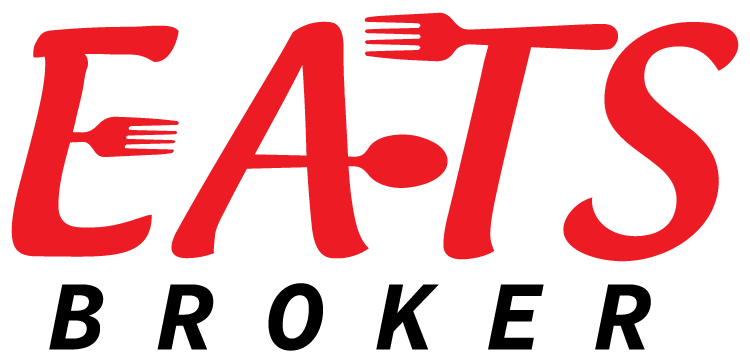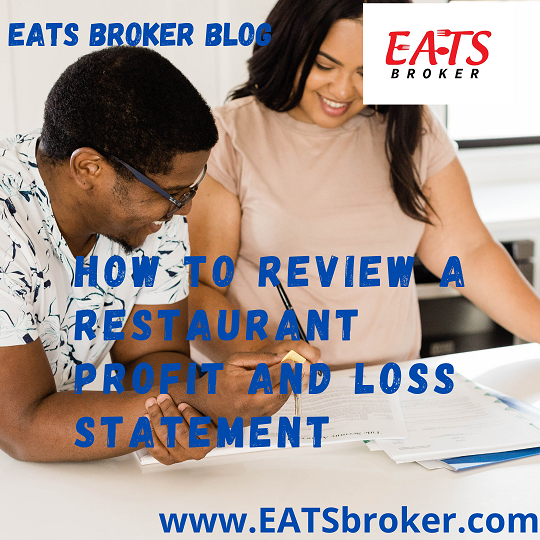Understanding how to review a Restaurant Profit and Loss Statement is a crucial variable for a Restaurant Valuation to determine the restaurant’s actual value. Restaurants are one of the industries that the ratios on a profit and loss statement can give valuable clues on how a seller operates his/her restaurant.
Unexperienced buyers will look straight down to the Net Income number when reviewing a Profit and Loss Statement. Experienced restaurant operators/buyers will start from the top and work down; they will check the key variables’ ratios.
EATS Restaurant Brokers -5 Critical Categories to review ratio percentages on a Profit and Loss Statement:
• Sales
• Cost of Goods Sold
• Payroll
• Rent/ Occupancy
• Net Income
Let’s start from the top of the Profit and Loss Statement:
1. Sales: This category is the most critical number because all the other key variables are based on the net sales number. Today, restaurant owners can automatically pull the total sales numbers from an integrated Point of Sale( POS). Total Sales is a good indicator to show if the restaurant sales are improving or declining yearly.
2. Cost of goods sold (COGS): Refers to the direct costs of producing the goods sold by a restaurant. Cost of Goods should typically run around 28%-32% of sales. This number can increase or decrease depending on the restaurant concept.
Example:
Pizza restaurants COGS are usually lower, ranging from 25%-28%
Full-Service Restaurants COGS are higher, ranging from 33%-36%
Sub Sandwich Franchise COGS typically range from 28%-33%
3. Payroll: Includes labor cost, including hourly and salaried, payroll taxes, 401K contributions, and other employee benefits. An average payroll rate should be around 25%.
Restaurant Brokers come across some diverse Payroll expense ranges when providing restaurant valuation. Here are some scenarios:
-Low under 20%- Restaurant has family members working extensive hours, or husband and wife are working over 40 hours weekly
-Low under 20%-Owner debits some payroll expenses under Cost of Goods Sold (COGS).
-Low under 20%-The most common scenario is CASH-owner is paying employees in CASH, aka under the table.
(These factors are essential because they make a difference in the restaurant valuation)
4. Rent/ Occupancy Expense: Occupancy costs are costs related to occupying space, including; rent, real estate taxes, personal property taxes, and insurance on the building. Occupancy Costs should be between 7%-11% of sales.
EATS Restaurant Brokers Tip-PAY CLOSE ATTENTION TO THIS LINE:
Occupancy Costs that are 5% or less and 12%-18% should get an experienced Restaurant Broker’s attention providing a restaurant valuation. Leases that have a monthly occupancy cost of 12%-18% are an indication of a bad lease. This ratio number for rental occupancy can be challenging for restaurant owners trying to sell a restaurant to a buyer.
On the opposite end, Occupancy Cost that is 5% or less should be explained in detail. In most cases, the restaurant seller owns the building and pays a low mortgage, or the landlord provided reduced rent as a concession.
5. Net income (NI), also called net earnings, is calculated as sales minus the cost of goods sold, selling, general and administrative expenses, operating expenses, depreciation, interest, taxes, and other expense.
Restaurant Net Incomes usually range from 5%-10%, a well-managed restaurant can see percentages increase up to 15%.
EATS Restaurant Brokers Tip-PAY CLOSE ATTENTION TO THIS LINE:
Net Income over 20% should be analyzed and explained. Most times, sellers are not deducting all expenses, under-reporting numbers, or combining multiple restaurant expenses.
**Disclaimer if the seller provides a net income over 20% for numerous years on the TAX RETURNS, then it makes it easier to believe.
Restaurant Sellers should understand their Profit and Loss statement and be ready to explain specific ratios if they are irregular from the average ratio ranges. EATS Broker reviews restaurant Profit and Loss Statements daily. We understand the restaurant business down to the percentage numbers.
EATS Broker are Subject Matter Experts in Restaurant resales. Let us provide you a complimentary Certified Restaurant Valuation; contact us today at [email protected]
or 404-993-4448.

